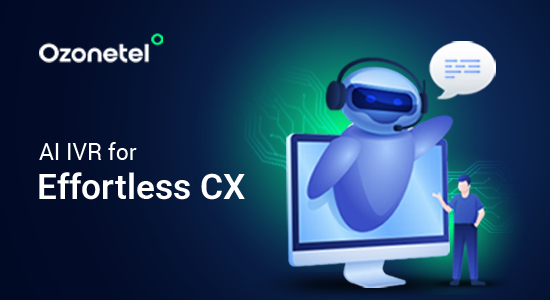- Resources
- Customer Experience vs Customer Service
Customer Experience vs Customer Service
![Customer Experience Vs Customer Service [+Examples]](https://ozonetel.com/wp-content/uploads/2024/05/customer-experience-vs-customer-service.jpg)
Customers, in this hyper-connected world, hold immense power — they can effortlessly switch brands with a tap on their phone, making it crucial for businesses to prioritize both customer service and customer experience. However, the distinction between customer service and customer experience is often blurred, leading many businesses to get confused between the two concepts.
So, how are they different? Well, customer service focuses on resolving specific customer issues, typically during a single interaction. Did their product malfunction? Do they need help navigating your website? Customer service tackles these immediate concerns — 60% of customers believe speed is the most important part of good customer service.
Customer experience (CX), however, encompasses the entire customer journey. Think of it as a bird’s view of every touchpoint a customer has with your brand, from their initial awareness to post-purchase interactions. Why is this important? Data highlights that 77% of customers are more loyal to a company that provides a positive customer experience when problems arise.
In this article, we discuss these two terms in more detail, elaborating on their importance for businesses and how integration between the two can enhance your customer satisfaction rate. Read along!
In this article, we will explore:
- 1. What Is Customer Service?
- 2. Key Components of Customer Service
- 3. What Is Customer Experience?
- 4. How Does CX Impact the Customer Journey?
- 5. Customer Service vs. Customer Experience: Key Difference
- 6. Role of Customer Service in Shaping Customer Experience
- 7. 4 Real-World Customer Service Examples
- 8. Importance of Aligning Your Customer Service Strategy With CX Goals
What Is Customer Service?
Customer service is the backbone of a successful business, playing a pivotal role in shaping the overall customer experience. It encompasses various activities, from answering questions and resolving complaints to providing guidance and offering personalized solutions.
The strategy is about understanding and anticipating customers’ needs and preferences. It goes beyond simply addressing immediate concerns; it involves building trust, demonstrating empathy, and creating a positive experience that leaves a lasting impression.
Effective customer service requires representatives who possess an in-depth understanding of the products or services offered and the ability to actively listen, communicate clearly, and provide prompt and tailored solutions.
Moreover, the impact of exceptional customer service cannot be overstated – it plays an important role in improving brand loyalty, retaining existing customers, attracting referrals, and increasing customer lifetime value.
Businesses prioritizing customer service differentiate themselves from competitors, creating a distinct advantage in the market. Also, satisfied customers have a higher chance of making repeat purchases, recommend the brand to others, and remain loyal advocates.
Key Components of Customer Service

Now that we’ve established the essence of customer service let’s dissect the key components that make it truly effective. By understanding these elements, businesses can empower their customer service representatives to deliver exceptional experiences, fostering customer loyalty and brand advocacy.
Personalization
Personalizing customer interactions involves tailoring the experience to customer needs, preferences, and previous interactions with the brand. You can do this by implementing strategies for data analysis, customer segmentation, and targeted marketing campaigns. For example, a retail company could leverage purchase history data to provide personalized product recommendations or offer tailored promotions based on customers’ shopping behaviors.
Responsiveness
Customers expect prompt and efficient service; any delay in addressing their problems can lead to frustration and dissatisfaction. Responsiveness is key to ensuring a positive customer experience. By responding to these inquiries and resolving issues promptly, companies can showcase their dedication to customer satisfaction and build trust. This could involve implementing efficient processes, leveraging technology solutions, and ensuring adequate staffing to handle customer inquiries promptly.
Empathy
Empathy allows a company’s representatives to understand and share another person’s feelings, and it plays a crucial role in delivering exceptional customer service. By putting themselves in the customer’s place, agents can better relate to their pain points, concerns, and perspectives. This empathetic approach fosters a deeper connection and builds trust, as customers feel heard. An empathetic customer service representative might acknowledge a customer’s frustration and provide reassurance, demonstrating genuine care and a desire for a satisfactory resolution.
Professionalism
Professionalism involves maintaining a respectful, courteous, and dignified demeanor, even in challenging situations. Professional customer service representatives remain calm, patient, and composed, actively listening to customers and responding constructively, even when frustrated or dissatisfied.
This professionalism extends to communication style, appearance, and overall conduct, reflecting the brand’s values and commitment to excellence. For instance, a professional representative might acknowledge a customer’s concern, apologize for any inconvenience, and outline clear steps to resolve the issue, demonstrating a commitment to finding a satisfactory resolution.
Product Knowledge
Customer service representatives are often the face of a brand, and their knowledge of the products or services offered is crucial. Customers expect to interact with knowledgeable individuals who can provide accurate information, guidance, and solutions.
Moreover, comprehensive product training and ongoing education ensure that representatives deeply understand the features, benefits, and potential issues associated with the offerings. This expertise instills confidence in customers and enables efficient problem-solving and effective upselling or cross-selling opportunities.
What Is Customer Experience?
Customer Experience is the outcome of any engagement a person has with a brand. This covers marketing materials, product design and quality, customer service, internet interactions, sponsorships, employee public statements, retail looks, suppliers, and other aspects. Any interaction with something associated with a brand constitutes a customer experience. It influences customer perceptions and has a direct impact on the bottom line.
For instance, a company might have a user-friendly website that speaks directly to the needs of its target audience, effectively guiding visitors through the exploration and consideration phases. However, if the sales process is disjointed or lacks personalization, it can quickly erode the positive impression built during the initial stages, ultimately impacting the overall customer experience.
To solve this problem, customer experience strategies focus on delivering tailored, pleasing interactions at every touchpoint, from initial awareness and marketing campaigns to sales processes, customer service interactions, and post-purchase support. These touchpoints are interconnected, and each one has the potential to either reinforce or undermine the customer’s perception of the brand.
Customers no longer evaluate a brand solely based on its offerings; they seek personalized, seamless, and memorable experiences that promote a sense of connection and understanding. This is where customer experience plays an important role. To achieve this, firms need to have a 360-degree view of customer and complete integration of all customer touchpoints and data sources.
How Does CX Impact the Customer Journey?
CX encompasses the entire customer lifecycle, ensuring that every interaction, be it with your marketing, sales, or customer service teams, is tailored to meet each individual’s unique needs and expectations. It’s about understanding your customers’ pain points, anticipating their needs, and proactively addressing them before they even arise.
For instance, by leveraging data-driven insights, you can offer personalized recommendations or cross-sell complementary products, enhancing the overall experience and driving customer satisfaction.
Moreover, CX extends beyond the purchase stage. It’s about forming long-term relationships with your customers, providing exceptional support, and continuously seeking feedback to identify areas for improvement.
What we mean is that a well-designed CX strategy would ensure that your customer service team has the required tools and knowledge to resolve the issue efficiently. Additionally, the CX team may follow up with the customer, gathering feedback and using it to refine processes, preventing similar issues from occurring in the future.
Also, effective CX strategies leverage various tools, such as customer relationship management (CRM) platforms, to capture and analyze customer data, enabling you to deliver personalized experiences at scale. You can also deploy A/B testing tools to optimize messaging and user experiences, and dynamic recommendation engines to tailored product suggestions based on purchase history. This enhances your cross-selling and upselling opportunities.
Customer Service vs. Customer Experience: Key Difference
Customer service focuses on immediate customer assistance, often addressing specific issues or inquiries. Customer experience, on the other hand, is the overall journey and impression customers have with a brand, encompassing all interactions and touchpoints. To help you understand better, here’s a table differentiating between customer service and customer experience:
| Aspect | Customer Service | Customer Experience |
|---|---|---|
| Definition | Assistance or support provided to customers | Overall impression and journey of customers |
| Focus | Transactional, addressing specific issues | Holistic, encompassing all touchpoints |
| Goal | Resolve customer problems efficiently | Delight and retain customers |
| Interaction | Reactive, in response to customer inquiries | Proactive, anticipating and exceeding needs |
| Scope | Limited to interactions with service reps | Encompasses entire customer journey |
| Metrics | Response time, resolution rate | Satisfaction, loyalty, Net Promoter Score |
| Impact on Brand | Can affect perception if poorly handled | Strongly influences brand perception |
| Importance | Essential for problem resolution | Crucial for building long-term relationships |
| Examples | Answering inquiries, handling complaints | Seamless online shopping experience, loyalty programs |
Role of Customer Service in Shaping Customer Experience
While understanding the distinction between customer service and customer experience is important, it’s their interconnectedness that can help businesses enhance the customer journey. How? By in-depth understanding the diverse aspects of customer service, businesses can effectively implement it in their operations to establish a smooth customer experience.
Let’s delve deeper into how customer service excellence translates into an exceptional customer experience.
First Impression and Initial Touchpoint
The customer service team often serves as the first point of contact between a company and its customers. This initial interaction holds immense significance as it sets the tone for the entire customer experience. A positive and helpful interaction can leave a lasting impression, fostering trust and confidence in the company. Conversely, a negative experience can tarnish the customer’s perception, potentially hindering future engagement.
Effective Problem Resolution
One of customer service’s primary responsibilities is to address customer concerns promptly and efficiently. By listening to customers, empathizing with their problems, and diligently working to find suitable solutions, the customer service team can significantly enhance the overall customer experience. Effective problem resolution addresses immediate concerns and demonstrates the company’s commitment to customer satisfaction.
Building and Nurturing Relationships
Customer service interactions provide valuable opportunities to build strong relationships with customers. Through consistent and positive communication, the customer service team can foster trust, cultivate loyalty, and create a sense of value for the customer. This nurturing of relationships enhances the overall customer experience and increases the likelihood of repeat business and customer referrals.
Ongoing Support and Assistance
Customer service extends beyond the initial purchase or problem resolution. It should be available throughout the entire customer journey, providing ongoing support and assistance whenever needed. By offering prompt and reliable support, companies demonstrate their commitment to customer satisfaction, ensuring customers feel valued and supported throughout their entire experience.
Gathering Valuable Feedback
Customer service interactions are valuable for gathering customer feedback, including suggestions, complaints, and preferences. This feedback provides invaluable insights into areas that require improvement, enabling companies to make necessary adjustments and enhancements to their products, services, and overall customer experience.
4 Real-World Customer Service Examples
Ozonetel, a leading CX platform, has enabled numerous businesses across various industries to streamline their customer service operations and deliver exceptional customer experiences.
Here are four examples that showcase Ozonetel’s customer service capabilities:
Wakefit
Wakefit is a research and innovation-driven sleep and home solutions company. They aimed to improve operational workflow, enhance responsiveness, minimize delivery failures, and optimize logistics costs.
Challenges
- Improve operational efficiency and customer responsiveness
- Minimize delivery failures and optimize logistics costs
- Address repeat queries and optimize executive bandwidth
Results
- 400% higher First Contact Resolution (FCR) rate
- 10% reduction in delivery failures
- 5% reduction in product return rate
- 25% decrease in resolution time
- 25% reduction in operational costs
ACKO Insurance
ACKO is a tech-first insurance company that wants to leverage technology to simplify its customers’ insurance experience, including policy inquiries, claims, and renewals.
Challenges
- Reduce time spent in the IVR
- Accelerate speed of resolution
- Automate query resolution
Results:
- 20% decrease in time spent in the IVR
- 20% higher routing accuracy
- 50% faster resolutions
- 90% customer satisfaction (CSAT) score
- 3,000 successful self-service resolutions per month
Leading Non-Banking Finance Company (NBFC)
A leading NBFC in India wanted to leverage technology and automation to optimize sales, accelerate responsiveness, and enhance the overall customer experience.
Challenges
- Drive business growth by enhancing sales and customer service
- Reduce lead response times and improve conversions
- Automate query resolution and reduce agent workloads
Results
- 3X increase in conversions
- 50% of queries are resolved through automation
- 65% increase in Net Promoter Score (NPS)
- 75% reduction in after-call work
- 5X improvement in agent efficiency
National Health Authority (NHA) for PM-JAY
The National Health Authority (NHA) implemented Ozonetel’s AI-based contact center solution to support its flagship public health insurance policy, PM-JAY, catering to 550 million Indians.
Challenges
- Efficiently monitor and improve the performance of 900+ remote healthcare advisors
- Automate call quality monitoring and identify agent training needs
- Enhance overall service quality and citizen satisfaction
Results
- Automated call quality audits for 900 healthcare advisors
- Analyzed over 122,000 hours of conversations in 11 vernacular languages
- 30 hours saved per supervisor per month on-call analysis
- Improved first-contact resolution and quality of conversations
- Increased citizen satisfaction
Importance of Aligning Your Customer Service Strategy With CX Goals
Consider a common scenario: a customer has a seamless browsing and purchasing experience on your website, only to encounter a brusque, unhelpful service representative when they have a follow-up question or issue. This disconnect can undo all the goodwill built during the initial purchasing journey.
Conversely, when customer service is an integrated extension of your CX approach, you create a cohesive, unified experience that reinforces brand loyalty. How? By mapping out every touchpoint in the digital customer journey, identifying areas for improvement in your organization. This deep insight allows them to craft a customer service strategy that anticipates and addresses customer concerns before they arise.
Moreover, when your customer service strategy is aligned with your CX goals, you create a cohesive, customer-centric ecosystem that drives long-term success. Every department, from product development to marketing, works harmoniously to deliver a consistent, exceptional experience that keeps customers returning and advocating for your brand.
Conclusion
Companies that prioritize and invest in crafting seamless, personalized journeys across every touchpoint are well-positioned to differentiate themselves, foster long-lasting relationships with their customers, and drive sustainable growth. However, achieving true customer experience excellence requires a comprehensive, integrated approach that harmonizes automation and human interaction.
This is where Ozonetel’s unified CX Hub shines. By offering a flexible, scalable, and robust platform that seamlessly manages omnichannel communications, Ozonetel empowers businesses to deliver tailored experiences at every stage of the customer journey.
With its intuitive interface, seamless CRM integrations, and robust security features, the CX Hub enables organizations to streamline operations, enhance agent productivity, and continuously optimize customer experience strategies.
Want to see what Ozonetel can do for your company? Sign up today for a free 7-day trial.
Prashanth Kancherla
Chief Operating Officer, Ozonetel Communications
Over the past decade, Prashanth has worked with 3000+ customer experience and contact center leaders...
Chief Operating Officer, Ozonetel Communications
Over the past decade, Prashanth has worked with 3000+ customer experience and contact center leaders to comprehensively understand the need for effective and efficient customer communications at every step of their journey with a brand. Deeply embedded in today’s CCaaS ecosystem, he has been instrumental in Ozonetel's growth and contributed in various roles including product management, sales, and solution architecture.







